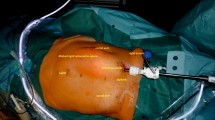Abstract
Purpose
A primary lumbar hernia is a rare entity that requires surgical management, but the preferred technique has not been established. We herein describe a standardized and reproducible retroperitoneal totally endoscopic prosthetic (TEP) repair technique for primary lumbar hernias.
Methods
Ten adult patients with primary lumbar hernias underwent retroperitoneal TEP repair from February 2019 to July 2020. A sufficient retroperitoneal space was established to accommodate a non-coated polypropylene mesh to reinforce the weakened flank area, and hernia content reduction and defect closure were then performed. The patients’ clinical data were prospectively collected and analyzed.
Results
Nine patients had a primary superior lumbar hernia and one patient had a primary diffuse lumbar hernia. All operations were successfully performed without serious intraoperative complications. The mean defect area was 6.4 ± 2.8 cm2 (range 4–12 cm2), and the mean mesh area was 144.6 cm2 (range 130–180 cm2). The average operative time (skin to skin) was 49.0 ± 5.7 min (range 40–60 min), and intraoperative bleeding was minimal. The mean visual analog pain scale score at rest on the first postoperative day was 2.2 (range 2–3). The average length of postoperative stay was 1.5 days (range 1–2 days). No serious postoperative complications occurred. No recurrence, chronic pain, or mesh infection occurred during a mean follow-up period of 7.5 months.
Conclusions
The retroperitoneal TEP repair for primary lumbar hernias is safe, efficient, and reproducible. Anti-adhesive coated meshes and fixation tackers are not required, making this a cost-effective procedure that is worthy of recommendation.


Similar content being viewed by others
References
Heniford BT, Iannitti DA, Gagner M (1997) Laparoscopic inferior and superior lumbar hernia repair [J]. Arch Surg 132(10):1141–1144
Hafner CD, Wylie JH Jr, Brush BE (1963) Petit’s lumbar hernia: repair with Marlex mesh[J]. Arch Surg 86(2):180–186
Henriksen NA, Kaufmann R, Simons MP et al (2020) EHS and AHS guidelines for treatment of primary ventral hernias in rare locations or special circumstances. BJS Open 4(2):342–353. https://doi.org/10.1002/bjs5.50252
Moreno-Egea A (2007) Controversies in the current management of lumbar hernias[J]. Arch Surg 142(1):82
Cavallaro G, Sadighi A, Paparelli C et al (2009) Anatomical and surgical considerations on lumbar hernias[J]. Am Surg 75(12):1238–1241
Watson LE (1946) Hernia, 3rd edn. Mosby-Year Book, St Louis, pp 443–446
Edwards C, Geiger T, Bartow K et al (2009) Laparoscopic transperitoneal repair of flank hernias: a retrospective review of 27 patients[J]. Surg Endosc 23(12):2692–2696
Wantz GE (1995) Spegelian, lumbar, and obturator hernias. In: Current Surgical Therapy. 5th ed. St Louis, Mosby-YearBook Inc, pp 496–499
Dowd CN (1907) Congenital lumbar hernia at the triangle of Petit. Ann Surg 45:245–248
Burick AJ, Parascandola SA (1996) Laparoscopic repair of a traumatic lumbar hernia: a case report. J Laparoendosc Surg 6(4):259–262. https://doi.org/10.1089/lps.1996.6.259
Habib E (2003) Retroperitoneoscopic tension-free repair of lumbar hernia. Hernia 7(3):150–152. https://doi.org/10.1007/s10029-002-0109-6
Meink AK (2003) Totally extraperitoneal laparoendoscopic repair of lumbar hernia. Surg Endosc 17:734–737
Chen DC, Hiatt JR, Amid PK (2013) Operative management of refractory neuropathic inguinodynia by a laparoscopic retroperitoneal approach[J]. Jama Surg 148(10):962
Zhao G, Wang Z, Hu M et al (2018) Preliminary clinical experience with robotic retroperitoneoscopic pancreatic surgery. World J Surg Oncol 16(1):171. https://doi.org/10.1186/s12957-018-1468-5 (Published 2018 Aug 16)
Fagenholz PJ, Thabet A, Mueller PR, Forcione DG (2016) Combined endoscopic trangastric drainage and video assisted retroperitoneal pancreatic debridement—the best of both worlds for extensive pancreatic necrosis with enteric fistulae. Pancreatology 16(5):788–790. https://doi.org/10.1016/j.pan.2016.06.009
Hu M, Zhao G, Xu D, Ma X, Liu R (2011) Retroperitoneal laparoscopic hepatectomy: a novel approach. Surg Laparosc Endosc Percutan Tech 21(5):e245–e248. https://doi.org/10.1097/SLE.0b013e31822de0ac
Jian Z, Jin H, Yin Z et al (2015) Laparoscopic retroperitoneal hepatectomy for a subcapsular hepatocellular carcinoma[J]. Ann Surg 262(2):77–78
Rosen MJ, Ponsky L, Schilz R (2007) Laparoscopic retroperitoneal repair of a right-sided Bochdalek hernia[J]. Hernia 11(2):185–188
Vaillancourt C, Lafond J (2009) Human embryogenesis: overview. Methods Mol Biol 550:3–7. https://doi.org/10.1007/978-1-60327-009-0_1
Acknowledgments
We thank Dr. Si X and Dr. Hua L from Shanghai, Dr. Miao J from Guangdong, Dr. Yang G, Dr. Jiang L, Dr. Gong Y and Dr. Zeng Y from Sichuan, Dr. Liu G from Zhejiang, Dr. Zhang L from Henan for their valuable contributions to this paper.
Funding
This work was supported by the Beijing Hospitals Authority Youth Programme (Code: QML20170307).
Author information
Authors and Affiliations
Corresponding author
Ethics declarations
Conflict of interest
The authors report no conflicts of interest.
Ethics approval
This study was approved by the institutional ethical review boards of all involved hospitals.
Statement of human and animal rights
All procedures performed in the study involving human participants were in accordance with the ethical standards of the institutional review board/international ethics committee for each center and with the 1964 Helsinki declaration and its later amendments. This article does not contain any studies with animals performed by any of the authors
Informed consent
All patients provided informed consent preoperatively.
Additional information
Publisher's Note
Springer Nature remains neutral with regard to jurisdictional claims in published maps and institutional affiliations.
Rights and permissions
About this article
Cite this article
Li, B., Yu, J., Qin, C. et al. Retroperitoneal totally endoscopic prosthetic repair of primary lumbar hernia. Hernia 25, 1629–1634 (2021). https://doi.org/10.1007/s10029-020-02334-z
Received:
Accepted:
Published:
Issue Date:
DOI: https://doi.org/10.1007/s10029-020-02334-z




